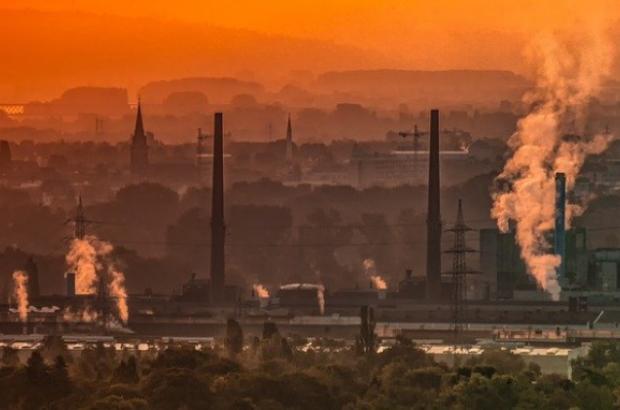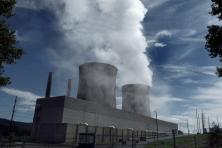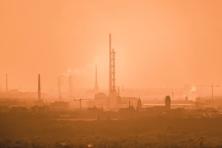One major component of the Oregon Climate Action Plan is a directive for the state Department of Environmental Quality (DEQ) to set up a new program to “cap and reduce” climate-harming pollution from Oregon’s large polluters.
As DEQ begins its public process for structuring this program, let's take a look at what’s at stake and answer some frequently asked questions about cap-and-reduce and how you can get engaged.
 In this article:
In this article:
- What's at stake?
- Frequently Asked Questions (FAQs)
- What exactly is "cap-and-reduce"?
- Why is a cap-and-reduce program necessary for climate progress?
- Will cap-and-reduce look like cap-and-invest, à la the Clean Energy Jobs bill?
- Which sources of pollution could this program cap?
- On what parts of this cap-and-reduce program is DEQ seeking public input?
- What would a strong cap-and-reduce program look like?
- What progress has DEQ made in developing this cap-and-reduce program?
- What's next?
 What’s at stake?
What’s at stake?
Climate change is a threat multiplier. It harms public health in myriad ways, from rising temperatures leading to more intense heat waves, droughts, wildfires (and months of smoke), to toxic algae blooms in drinking water and increased spread of infectious diseases. These devastating effects of global warming are projected to continue worsening across Oregon, while disproportionately harming Native American tribes, Black, Latinx and other communities of color, lower-income households, rural communities, and other historically marginalized communities.
As one example, this summer, Oregon Governor Kate Brown declared a drought emergency in eleven rural counties due to low water reservoir levels and hot, dry conditions. In addition to dealing with these drought conditions (and associated wildfires), the Warm Springs reservation has not had potable running water for months.
That bears repeating: amid a global pandemic, thousands of people in our own state have not had access to safe running water to drink, cook with, wash hands, and put out wildfires. This is a stark example of our collective inaction on climate change manifesting as extreme injustice and systematic racism in action.
Oregon needs to step up and protect our people, communities, natural resources, economy, and wild places by curbing climate pollution, improving air quality and health, and creating high-quality jobs in the clean energy economy.
The cap-and-reduce program, along with the other actions directed in the Oregon Climate Action Plan are powerful tools we can use to rein in our pollution and bring the benefits of climate action to our communities.
 Frequently Asked Questions (FAQs)
Frequently Asked Questions (FAQs)
 Q: What exactly is “cap-and-reduce”?
Q: What exactly is “cap-and-reduce”?
The Oregon Climate Action Plan (OCAP) requires the Oregon Department of Environmental Quality (DEQ) to develop a regulatory program that limits and progressively reduces climate-harming pollution from major sources in the fossil fuel and other industrial sectors. This will likely include DEQ setting and enforcing a declining limit on greenhouse gas pollution for these sources.
The specific details of the program have yet to be determined, but DEQ is holding a series of technical workshops and town halls through the fall to discuss program design options before they begin the formal rulemaking process that is scheduled to conclude by end of 2021.
 Q: Why is a cap-and-reduce program necessary for climate progress?
Q: Why is a cap-and-reduce program necessary for climate progress?
Despite our ever-shortening window for action and major climate impacts killing, harming and disrupting people’s lives right now, Oregon continues emitting more climate pollution every year, further fueling the crisis. In fact, Oregon releases more climate-harming pollution than 116 entire countries (all of whom have signed onto the Paris climate agreement).
This cap-and-reduce program is a new tool to help reverse this trend and enforce our state’s pollution reduction targets. Big Oil and industrial polluters have been spewing limitless amounts of climate pollution into our air for decades. Cap-and-reduce aims to curb emissions from the biggest sources of climate pollution in our state.
These big corporate and fossil fuel entities are also best positioned to reduce their emissions—most likely by investing in cleaner energy sources, lower-carbon fuels, electrification, and clean tech innovation. As a result, the cap-and-reduce program can help deliver cleaner air and a more stable climate for everyone.
 Q: Will cap-and-reduce look like cap-and-invest, à la the Clean Energy Jobs bill?
Q: Will cap-and-reduce look like cap-and-invest, à la the Clean Energy Jobs bill?
Cap-and-reduce is aimed at reducing pollution from many of the same big polluters as the Clean Energy Jobs bill, but relies on the Oregon Department of Environmental Quality’s existing authority to do so.
The cornerstone of the Clean Energy Jobs bill (i.e. cap-and-invest) was a market-based auction mechanism that allowed for the buying, selling, and trading of allowances between polluters to incentivize reductions and raise money for climate investments.
We don’t yet know exactly what form cap-and-reduce will take, but it is unlikely to involve auctions or money raised for climate investments. However, DEQ can still require emissions reductions and thereby incentivize investments that reduce climate and air pollution.
 Q: Which sources of pollution could this program cap?
Q: Which sources of pollution could this program cap?
Essentially, the Oregon Department of Environmental Quality has the authority to regulate the biggest sources of climate-harming pollution in Oregon, which include the sectors burning the most fossil fuels:
|
|
stationary sources like industrial manufacturing and gas power plants; |
|
|
transportation fuels like gasoline and diesel; and |
|
|
other liquid and gaseous fuels, including fossil gas (i.e. "natural" gas). |
If DEQ adopts a comprehensive approach, this program could cover sources responsible for more than half of Oregon’s greenhouse gas emissions.
 Q: On what parts of this cap-and-reduce program is DEQ seeking public input?
Q: On what parts of this cap-and-reduce program is DEQ seeking public input?
DEQ is currently seeking input on all aspects of the program before it begins its formal rulemaking. The decisions that DEQ makes on this program will have major implications on whether we are able to tackle the climate crisis and meet our state’s climate goals. Some of the key program design elements DEQ is looking for input on include:
- Which greenhouse gases should the program cover
- Which sources should be included
- How quickly should the cap decline
- How can priorities of environmental justice communities be incorporated
- Should the program allow for alternative compliance options
 Q: What would a strong cap-and-reduce program look like?
Q: What would a strong cap-and-reduce program look like?
A strong cap-and-reduce program should significantly reduce climate pollution, while achieving just and equitable outcomes. We believe these are some vital features:
|
|
Guarantee reductions of climate pollution are reached at the pace and scale necessary to meet the state’s mandatory climate targets; |
|
|
Require and incentivize early reductions of climate pollution, rather than pushing reductions out to later years; |
|
|
Based on the best available science; |
|
|
Include all polluters that DEQ has the authority to regulate (ensuring no exemptions, perverse incentives, or windfall profits); |
|
|
Maximize the benefits for, and prioritize the needs and interests of impacted communities; |
|
|
All advisory and oversight committees should have an overrepresentation of communities of color and other frontline communities; |
|
|
Continuous monitoring and oversight with evaluation of metrics that account for equity, environmental protections, and efficacy; and |
|
|
Adequately staffed and funded to run effectively. |
 Q: What progress has the Oregon Department of Environmental Quality made in developing this cap-and-reduce program?
Q: What progress has the Oregon Department of Environmental Quality made in developing this cap-and-reduce program?
DEQ is currently in Phase 2 of its work to develop the program. Phase 1 included the development of a report to the governor outlining the process it plans to use over the next year or so to develop the program. In Phase 2, DEQ is continuing to solicit public input to help inform policy options before the official rulemaking process begins. There are a total of nine public meetings scheduled between August and October:
- Technical workshops
- Wednesday, August 19th: Program Scope
- Wednesday, August 26th: Program Stringency
- Wednesday, September 2nd: Alternative Compliance Options
- Wednesday, September 9th: Distribution of Compliance Instruments
- Tuesday, September 15th: Cost Effectiveness
- Thursday, September 17th: Impacted Communities
- Town halls
- Thursday October 1st
- Thursday, October 8th
- Wednesday, October 14th
DEQ is providing relevant issue briefs and other educational materials in advance of the meetings, and is seeking both verbal and written comments from the public. The formal rulemaking process is scheduled to begin Fall/Winter 2020 and should be completed by October 2021 (more information can be found on DEQ’s cap-and-reduce webpage).
 What’s next?
What’s next?
Along with our partners in the Renew Oregon coalition, our Climate Solutions Oregon team is providing guidance at each of the technical workshops to help ensure DEQ brings forth the best cap-and-reduce program to meet our climate goals and address long-standing inequalities related to air pollution from industries and fossil fuels. As we approach the town hall dates, we’ll be asking you to join via web conference to make your voice heard on these issues. Stay tuned!






